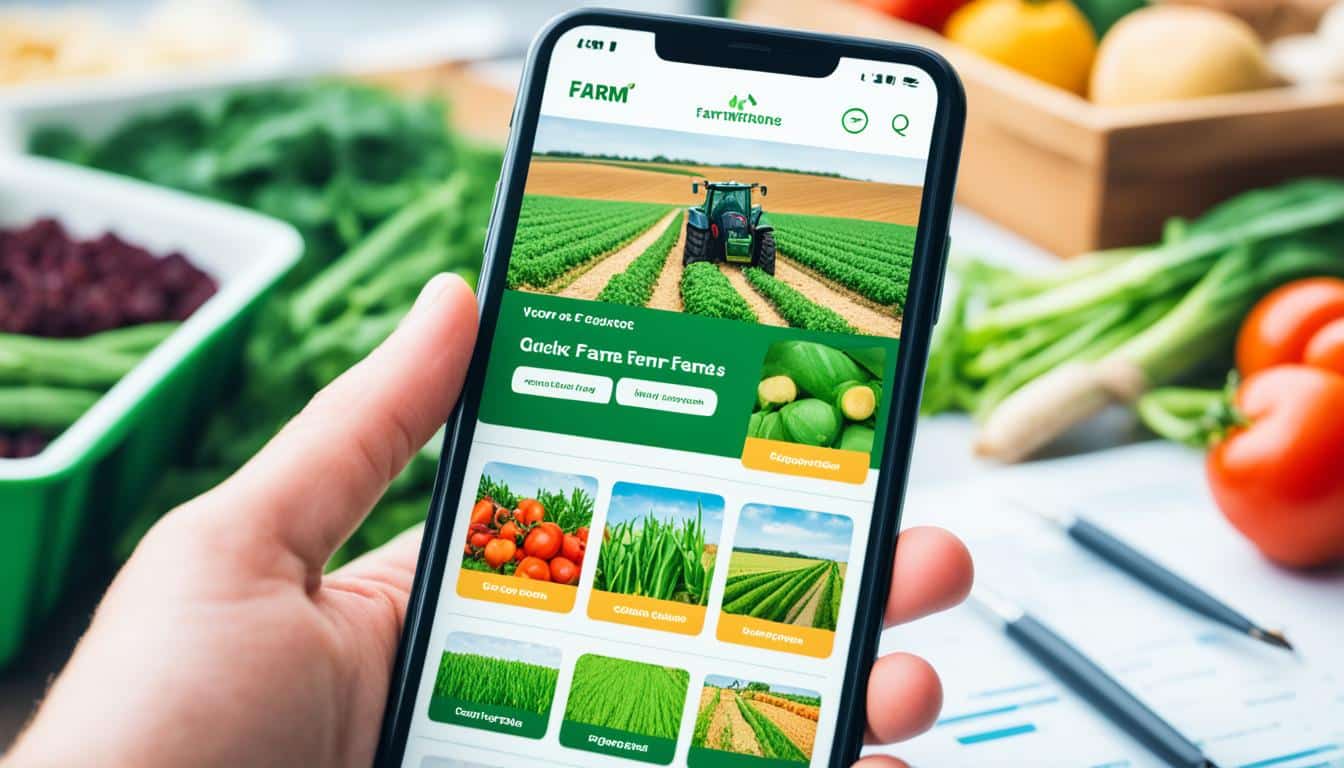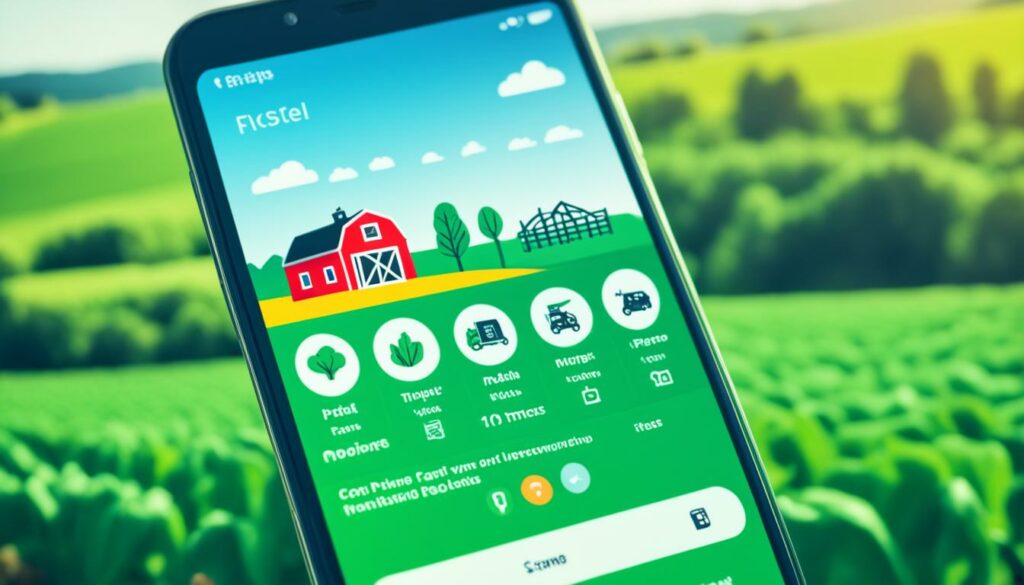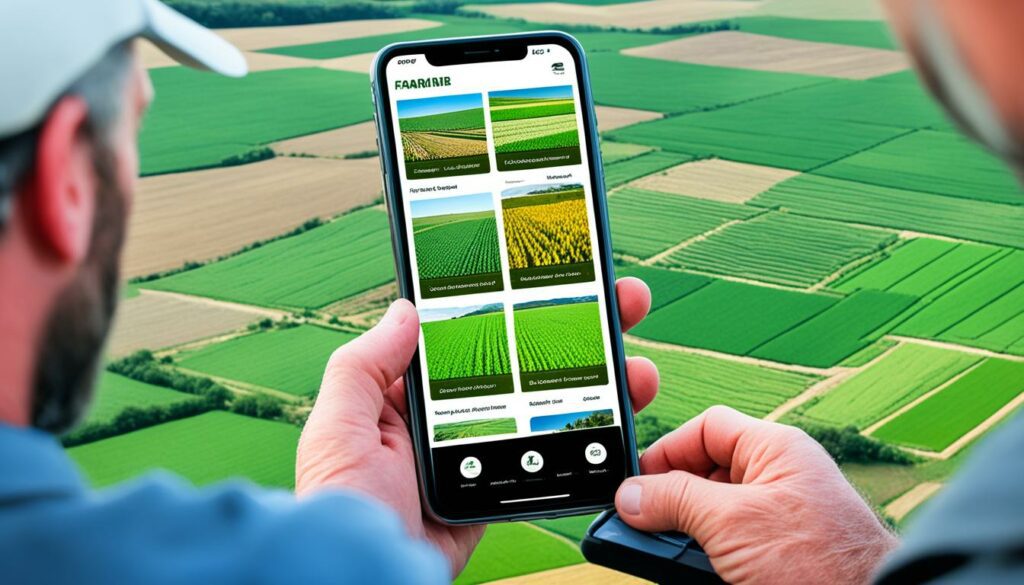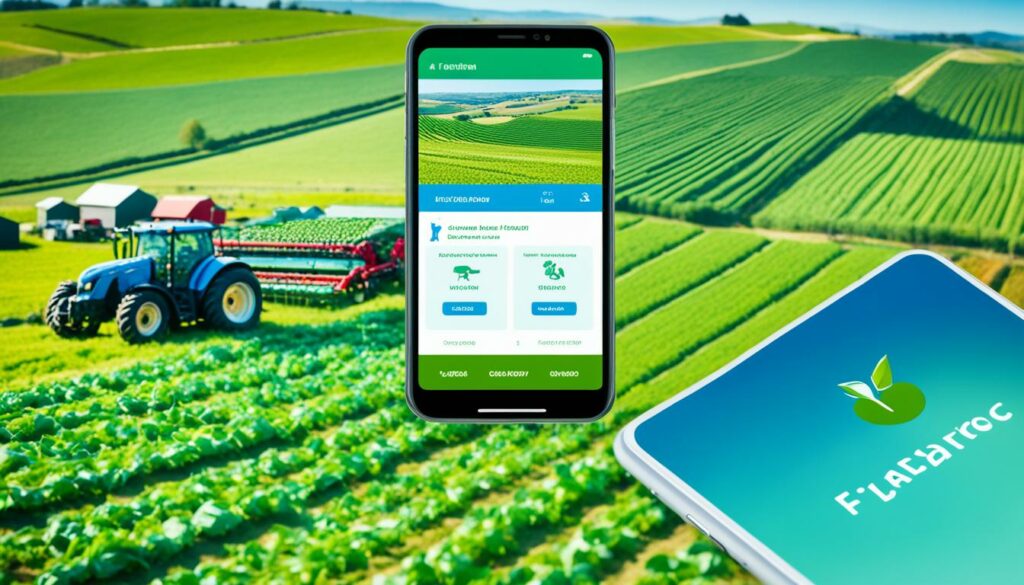Menu

Users make up their mind about a website quickly, in just 50 milliseconds. This fact shows how vital it is to have farm websites that work well on mobile phones. In the modern world, more than half of people look up businesses on their phones. This means having a website that looks good and works well on mobile is crucial. For the farming sector, mobile-friendly sites are even more important. Apps like Agerpoint Capture and AGvisorPRO are changing how farmers handle data and tasks.
Today, farmers and experts use mobile apps to work smarter and reach more people. From Florida Milk with its special milk, to Bowles Farming Company’s long history in California, there is a wide range of farms. Having websites that work on mobiles helps these farms stay up to date. It makes it easier for customers to interact with them and boosts their visibility online.
A great farm website does more than look good on mobiles. It also helps connect old farming methods with new technology. For example, Columbia Farms focuses on eco-farming, and BioPhero uses smart methods to control pests. These examples show how important mobile optimization is for farms today.
Technology is changing farming, making it more efficient and sustainable. A big part of this change is making sure websites work well on mobiles. This is key for farmers to access important info and tools on the go.
Today, many vital farm tasks are done through mobile apps. From managing crops to tracking animals, these tools are a big help. They save time, keep the land healthy, and manage data in real time.
By making farm websites mobile-friendly, farmers can use these apps better. For instance, apps like Acres and Aeroview InField help with farm planning and managing water use.
More and more farmers rely on mobiles for their work. The use of smart farming is rapidly growing. By 2026, this industry could be worth over $34 billion.
Mobile apps are not only handy but also cost-effective. They teach farmers better ways to grow food and warn about crop problems. This makes mobile-friendly websites crucial for farmers to stay informed and efficient.
Looking at the facts, it’s clear that making websites mobile-friendly is necessary for farmers now. With mobiles becoming central in farming, websites must keep up. They need to be easy to use and helpful for all tasks.
Most internet users now check websites on phones or tablets. So, mobile-friendliness for farm sites is key. Search engines like Google prefer mobile-friendly sites. This means that farm businesses need to use the best methods. They should ensure their websites work well on mobiles. This is important for modern farming.
Designing a mobile-friendly site starts with phones in mind. Then, it’s made to work on larger screens. Using responsive design is crucial. It makes the site look good on any device. Also, making images smaller and navigation simpler helps users a lot.

Mobile SEO may face challenges like working on different devices. Responsive web design tackles this by adjusting to any screen size. Also, slow internet speeds can make pages load slowly. Making images smaller and simplifying menus can help speed things up. Apps like Agerpoint Capture show why good design matters for mobiles.
| Challenges | Solutions |
|---|---|
| Device compatibility | Responsive web design |
| Slow load times | Minimising image sizes, optimising navigation |
| SEO performance | Implementing structured data, high-quality content updates |
Focusing on local SEO can bring more visitors. It sets relevant goals for your area. Using the right keywords and making your site mobile-friendly is smart. This boosts your site’s visibility. Working through mobile design challenges shows your commitment. It helps achieve the best in mobile website practices for farms.
Today, having a website that works well on mobiles is key for farms looking to use technology wisely. This isn’t just good for users; it boosts the farm’s success and earth-friendliness too.
Farm websites that are easy to use on phones offer a better experience. They let farmers quickly access info and tools on their mobiles. This is great for apps like AGvisorPRO and Traction Mobile, which help with decisions in the field.
A site that looks good on mobiles keeps users coming back. It’s easier for farmers to get the info they want fast. With mobiles, getting real-time data is smoother. This means farm sites that work well on phones get more visits.
Optimising for phones also helps farms show up better in search results. This means more people see the farm online. As more farmers use mobiles, good mobile sites will stand out. This helps farms connect with more people and grow.
The smart agriculture sector is set to double by 2026. This shows how important mobile technology is for farms. It’s key for making farms more productive and profitable, while also caring for the planet better.

Making farm websites mobile-friendly is key today. People use their phones a lot and often have slow internet. So, it’s important to make farm sites work well on mobiles. This makes sure users have a good experience.
Page speed is crucial for mobiles. To make a site faster, we can do things like use smaller images and save parts of the site in the browser’s memory. This means a site like Rainforest Foods loads quickly even with beautiful, high-res images.
For a site to work well on different devices, it needs a responsive design. Abrey Agricultural does this brilliantly. Their photos adjust to fit any screen perfectly, whether you’re using a phone, tablet, or desktop. This gives visitors a seamless viewing experience.
Mobile-friendly text and buttons are a must. The font must be clear, buttons easy to tap, and all information concise. Crazy About Eggs uses cool animations to make their site fun and easy to use. This is clever because it keeps visitors interested without being overwhelming.
Sites like Crazy About Eggs and Farmkart are shining examples of mobile SEO done right. They look great and work smoothly on phones and tablets. This helps them attract and keep customers online, which is vital for farms wanting to stand out online.
Creating a mobile-friendly website is more than making it look good. It’s about engaging users, reducing bounce rates, and improving SEO. Below, we explore how to make your farm website shine on mobile.
Responsive design is key for a great user experience. It adapts your site for different screens, making it always easy to use. This approach keeps bounce rates down and users happy.
Reducing image sizes is a top mobile optimisation tip. It cuts down on loading times, which can be slow with big images. This way, your site loads faster, and users stay longer.
Keep navigation simple with 7 tabs or fewer for better SEO. Easy menus help users quickly find what they’re looking for. It’s perfect for mobiles, making your site more accessible and engaging.
This graphic shows why these design strategies are so important for mobile:
| Strategy | Benefit | Example |
|---|---|---|
| Responsive Web Design | Improves user experience | Gripp’s user-friendly design facilitates digital operation tracking |
| Minimising Image Sizes | Reduces load times | WebFX optimises images for faster page loading |
| Simplifying Navigation Menus | Enhances user accessibility | Barn2Door’s streamlined design aids in easy navigation |
By using these methods, farm websites can look and work better on mobile. This improves the experience for all visitors.
In the world of mobile optimization farm websites, being fast and slick is key. Lots of us now browse online with our phones. So, it’s vital that farm sites load quickly for their visitors. Many farm sites are now working on being quicker and smoother. This makes users happy, and it helps the site do better in search results.

Using AMP technology can make farm sites do better on mobiles. AMP makes web pages simpler, so they load almost instantly. This speed is very important for mobile device websites. For example, apps like Agerpoint Capture and Agrology use AMP. They give up-to-the-minute info, making farm work easier on phones.
Making mobile optimization farm sites faster starts with the server. A quicker server response means pages load faster. This stops people from leaving because the site is slow. Even a one-second delay can hurt how many people stay on the site. It’s crucial to set up servers right and choose good hosting to keep users interested.
Getting rid of JavaScript that slows down loading is essential. This JavaScript makes pages take longer to load and can make people leave. By using tricks like putting JavaScript off or loading it without stopping other content, load times can get much faster. This makes Google happy, too, as it likes websites that are quick and mobile-friendly.
AMP, fast servers, and dealing with slow JavaScript are big parts of making a website great for mobiles. They help farm websites stay at the top of their game for everyone who visits.
| Strategy | Benefit | Example Application |
|---|---|---|
| AMP (Accelerated Mobile Pages) | Instant content delivery, higher conversion rates | Agerpoint Capture, Agrology |
| Reducing Server Response Time | Faster load times, lower bounce rates | Improved user engagement |
| Eliminating Render-Blocking JavaScript | Enhanced loading speeds, better SEO performance | Aid in higher search engine rankings |
Now, with digital changes happening fast, using the right tech and tools for mobile site improvements is key for farms. The goal is to make sure your farm’s website works well on mobiles and looks good too. Let’s look at three top tools for making this happen.
The Google Mobile-Friendly Test checks if your site’s good for mobiles. It looks at how easy your site is to use on phones and tablets. Then, it gives tips to make your site better and more mobile-friendly. This test is perfect for spotting and fixing problems on mobiles.
The Responsive Design Checker lets you see how your site looks on different screens. It checks your site on mobiles of all sizes, like phones and tablets. This is great for finding and fixing any layout issues to make your site run smoothly on any device.
PageSpeed Insights by Google is a must for checking your site’s speed. It looks at your site to see how fast it loads. Then, it gives advice on how to make it quicker. Since site speed is so important for mobiles, this tool is key for finding and fixing speed problems.
Using these tools right can make your farm’s website great for mobiles. This helps farmers use the latest apps easily, getting important info while they’re out.
Making mobile experience smooth is key for farm websites. Today, over 50% of the world gets online through mobiles. So, keeping navigation easy and text readable is crucial for user happiness and a successful site.

Farm websites must be easy to use with just your thumb. If a site doesn’t work well on mobiles, 48% of people think it doesn’t value them. Place interactive parts where thumbs naturally land to make using the site simple. This method is similar to how farming apps like DropControl make managing tasks like irrigation easier and faster.
Making text easy to read on phones is very important. 57% of users won’t suggest a business with a badly designed mobile site. To avoid this, use clear fonts, good contrast, and spacing in your design. This makes farm sites more fun and useful for people on the move, like AGMRI does for tracking farming concerns.
Optimising your site for mobiles is critical for farm business success. By giving attention to mobile SEO and mobile-friendly design, users get a positive, easy experience. This is key for farms to look trustworthy and do well online.
Making sure your farm website mobile compatibility is right is key. You need to test your site on many devices to give all users a smooth experience. Tools like Testsigma help test your site on over 3000 devices, ensuring it works well everywhere.
Using advanced testing tools like AWS Device Farm and Sauce Labs is crucial. They let you test on many devices at the same time and with real devices. This way, you can be sure your farm website works on all types of devices.
The table below shows useful tools for testing on different devices:
| Tool | Key Features |
|---|---|
| Testsigma | Automated test scenarios on 3000+ iOS and Android devices |
| AWS Device Farm | Concurrent testing on multiple devices |
| Sauce Labs | Large volume real device tests with low error rates |
| Firebase Test Lab | Free and paid plans with varied testing quotas |
| Samsung Remote Test Lab | Access to over 30 smartphone and tablet models |
| Xamarin Test Cloud | Tests on over 2500 mobile devices |
| Kobiton | Parallel execution and CI/CD pipeline integration |
With an expected increase in mobile devices up to 18.22 billion by 2025, it’s crucial to adjust. Most of these devices will be smartphones. In 2022, 77% of mobiles sold were smartphones, with Android and Apple iOS leading the way.
Combining tools like AWS Device Farm and Sauce Labs with others is the best approach to all-inclusive testing. This ensures your farm website is strong and friendly on all devices. It matches the goal of farm website mobile compatibility, making farming sites easy to use for everyone on the go.
More and more customers use smartphones for online browsing. So, ensuring farm websites work well on mobiles is crucial. Here are some top tips to make farm websites mobile-friendly.
To start, focus on having good content that’s easy to see on small screens. This draws in more buyers and makes your brand more visible. Short, fun articles, videos, and infographics are great for grabbing and keeping attention.

Using SEO and schema markup is key for better mobile search ranking. Schema markup helps search engines understand your content. This makes you easier to find in local searches. Also, it’s good to have on-page SEO and quality backlinks to boost your online reputation.
Pop-ups and interstitials can spoil the user experience on mobiles. They might make people leave your site fast. Instead of these, try using easy-to-see CTAs, like a bold “Shop Now” button. And, keep your site’s top-level navigation simple with seven or fewer tabs.
To sum up, creating a mobile-friendly farm website involves a full process. It’s about great content, SEO that search engines understand, and avoiding bad user experiences. If farms do these things well, their websites will be great on mobiles.
Looking at mobile-optimised farm websites’ case studies gives us important insights. These examples show how tech can make farming more effective. They also offer a design that works on mobiles well for today’s farming needs.
The team-up of Folio3 and Progressive Beef stands out. They got rid of a paper system, saving energy and time. This shows the power of mobile-friendly websites and strong back-end support.
At Vytelle, they made the Ovum Pick Up (OPU) process digital. This covered every step from place to paperwork to counting. It proves how impactful mobile optimization for farm websites can be.
Superior Farms switched over to software that meets USDA rules. This new software made managing location and quality data easier. Their move shows the value of a website that’s easy to use on mobiles.
Angus Media’s web app automated some bookkeeping, making things run smoother. This shows how a well-designed mobile site can improve work. Plus, they also had a tool for tracking goods and field work in real time, bettering how they do business.
These cases teach us a lot. For one, blending web and mobile tools, like AgriERP does, can really help. And making things digital, as with Angus Black Book, can boost how well you manage.
Other innovations, like PigWise, make looking after animals easier. They confirm that a mobile-friendly website brings big advantages. Additionally, personal insights from apps, like Growers Express, help make quick decisions in the field.
| Case Study | Key Achievements |
|---|---|
| Progressive Beef | Eliminated paper-based systems, improved feedlot compliance |
| Vytelle | Digitised OPU process, managed inventory |
| Superior Farms | Implemented USDA compliance management, digitised data |
| Angus Media | Automated sale book lifecycle, increased efficiency |
| Growers Express | Real-time insights, self-service analytics |
In summary, these studies reveal the huge impact of mobile-friendly farm websites. They show that a website designed for mobiles, plus smart tech in the back-end, can make farming more efficient. This benefits the whole agricultural sector.
Looking ahead, mobile SEO for farms is heading towards some exciting changes. New technologies like voice search, AI, and PWAs will change how we see mobile farm websites. Mobile optimisation will become even more important because of these trends.

Voice search is growing fast in popularity. People are asking their phones and smart speakers questions. To make your farm easy to find in voice searches, use long questions as keywords. This approach matches how people talk.
AI and machine learning are key to the future of mobile SEO. They can guess what users want and need very accurately. By using AI to know when you’ll have more visitors, or to offer them personalised experiences, your farm’s site can get ahead. This smart method of mobile SEO not only boosts your search results but improves how users interact with your site.
Progressive web apps are changing the game for farm websites on mobiles. PWAs offer many benefits of apps and the web but without needing to be installed. They work well offline and load quickly. By having a PWA, your farm site can work smoothly even in bad network areas. This improves user experience and mobile SEO.
Transitioning, these upcoming trends stress the need to lead in mobile SEO for farms. By focusing on voice search, AI, and PWAs, farm websites can stay efficient and strong in the digital scene.
Looking at how farming has evolved, it’s clear that websites need to be mobile-friendly. Making farm websites work well on mobiles helps users, boosts interaction, and gets better search results. To do this, farm websites use designs that fit any screen and make the pages load faster.
Top farms and companies show us how to do this right. For example, Columbi Farms turns to a round food system, seen well on their website. Florida Milk and Pipers Farm have welcoming sites with easy ways to find things. Plus, Pipers Farm uses a blog and an app to help the environment. Bowles Farming Company shares its long history online in a fun and real way.
Then, Beak and Skiff and Château Pédesclaux, through their events and classy websites, show why being good on mobiles matters. With companies like Farmkart and Gallica adding cool features and selling online, being mobile-friendly is key. This makes farming websites more important for today’s users.
Adding AI and machine learning is the next big thing for farm sites. It makes the digital world more alive and links us all better. As farm sites get smarter and easier to use, they become essential for everyone on their phones. This is just the start of an exciting time for digital farming.
Mobile optimisation is key for farms. It makes their websites user-friendly on mobile devices. Mobiles are now vital for farmers to manage crops, check the weather, and get market info. It also boosts user experience and SEO rankings.
Mobile-first design means the site is first built for mobiles, then for computers. It focuses on making the site look good and work well on small screens. To do this, we make sure the design fits any screen size, make images smaller to load faster, and keep the menus easy to use on mobiles.
To keep visitors coming back, make your website easy to use on mobiles. Offer quick info and a smooth experience. This makes people stay longer and visit again.
For good SEO on mobiles, focus on speed and design. Make the site load fast, look good on any screen, and have content that’s perfect for mobiles. This makes users happy and helps your site do well on mobile searches.
To design well for mobiles, use these tips. Make the site adjust to any screen. Keep images small and menus simple. This way, your website will work and look great on mobiles.
For mobiles, speed is vital. People expect to find what they need fast. Steps like using AMP and improving server response help make your site faster on mobiles.
Tools like Google’s Mobile-Friendly Test and PageSpeed Insights give you tips for better mobile sites. They check if your site works well on mobiles. They help you make it better.
To design for thumbs, put clickable things where they are easily reached by a thumb. Also, make sure buttons and links are big enough to be tapped with ease, no zooming needed.
Testing on many devices and browsers makes sure your site is good for all users. It prevents problems before they happen, giving everyone a smooth experience.
Optimising content for mobiles means making it easy to read and find in searches. Use special markups for SEO, and avoid pop-ups that block the screen. This makes your site better for mobiles.
Check out Acres and AgMatix for great examples. They use AI to make their sites work better. These sites show how good design meets powerful technology for a user-friendly experience.
Trends to watch for include making your site ready for voice search, using AI to make searching more accurate, and developing PWAs. PWAs work even when offline, a new way to keep users connected.